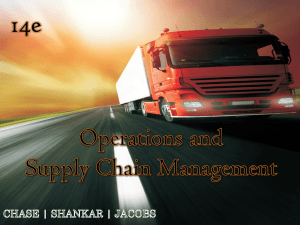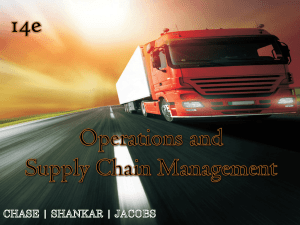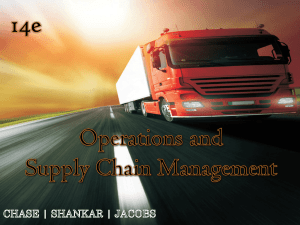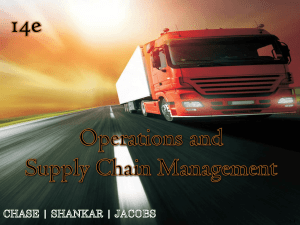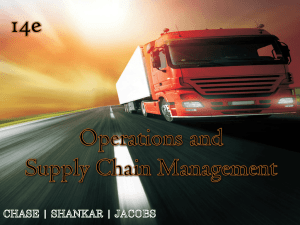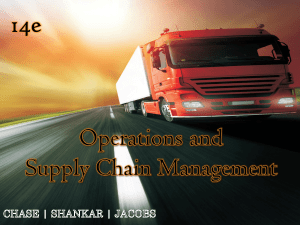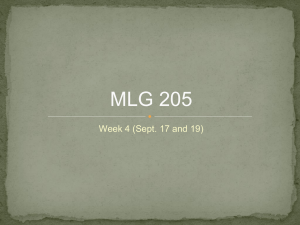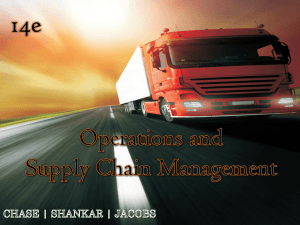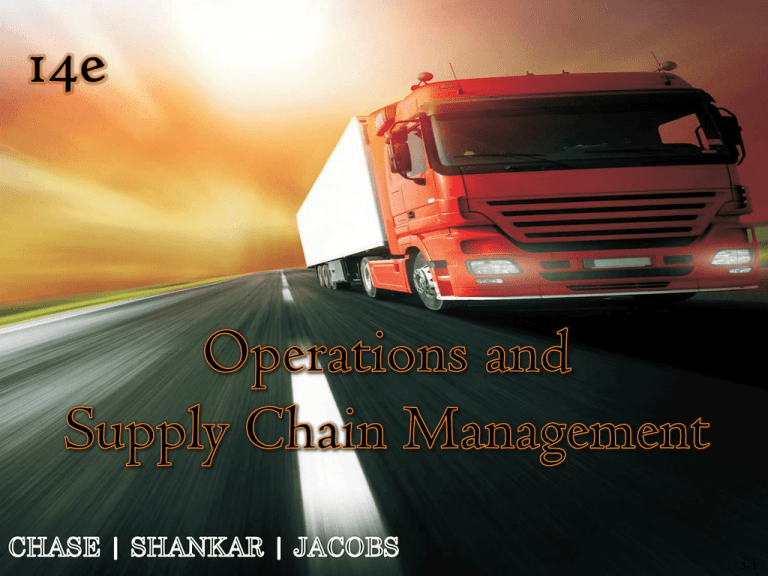
3–1
Chapter Three
McGraw-Hill/Irwin
Copyright © 2014 by The McGraw-Hill Companies, Inc. All rights reserved.
3–2
• LO3–2: Illustrate how different criteria can impact the
design of a product.
• LO3–3: Contrast how service products can have
different design criteria compared to manufactured
products.
Copyright © 2014 by McGraw Hill Education (India) Private Limited. All rights reserved.
• LO3–1: Know the issues associated with product
design and the typical processes used by companies.
• LO3–4: Evaluate the economic impact of a new
product on a company.
• LO3–5: Illustrate how product development is
measured in a company.
3–3
– Contract manufacturer: an organization capable of
manufacturing and/or purchasing all the
components needed to produce a finished product
Copyright © 2014 by McGraw Hill Education (India) Private Limited. All rights reserved.
• Companies continuously bring new products
to market
• Product design is integral to success
• Product design differs significantly depending
on the industry
• Companies often outsource major functions
3–4
– It provides potential access to a wide
variety of markets
– It increases perceived customer benefits
– It is hard for competitors to imitate
Copyright © 2014 by McGraw Hill Education (India) Private Limited. All rights reserved.
• Core competency: the one thing a
company can do better than its
competitors
• A core competency has three
characteristics:
3–5
• A pharmaceutical company may purchase information on
genetic targets from a genomics company, contract with a
specialist in combinatorial chemistry for rapid synthesis
and screening of candidate compounds, and even utilize a
contract research organization to conduct clinical trials but
retain ownership of the intellectual property (patents,
experimental data, trademarks, etc.) of the drug that
eventually comes to market.
Copyright © 2014 by McGraw Hill Education (India) Private Limited. All rights reserved.
• Sun Microsystems designs the SPARC chips used in its
high-performance workstations but subcontracts the
fabrication of those chips to specialized chip makers (while
maintaining ownership of the intellectual property).
3–6
Copyright © 2014 by McGraw Hill Education (India) Private Limited. All rights reserved.
• Dell has developed a set of highly specialized systems
that support its make-to-order operating strategy. Dell
has created a set of proprietary logistical processes that
range from the design of its web page through its
information systems infrastructure (a process that has
proved difficult for others to imitate). Dell owns the data
about what people are buying and in which
combinations. It also has been vertically integrated into
final assembly facilities that are designed to efficiently
produce in lot sizes of one. Finally, while it outsources
components, Dell uses longer-term relationships with its
suppliers and links them into its information system to
support quick response.
3–7
Defer judgment
Build on the ideas of others
Stay focused on the topic
One person at a time
Go for quantity
Encourage wild ideas
Be visual
Copyright © 2014 by McGraw Hill Education (India) Private Limited. All rights reserved.
•
•
•
•
•
•
•
3–8
Phase 0: Planning
•
Phase 1: Concept development
•
Phase 2: System-level design
•
Phase 3: Design detail
•
Phase 4: Testing and refinement
•
Phase 5: Production ramp-up
Copyright © 2014 by McGraw Hill Education (India) Private Limited. All rights reserved.
•
3–9
Copyright © 2014 by McGraw Hill Education (India) Private Limited. All rights reserved.
• Precedes project approval
• Begins with corporate strategy
• Includes assessment of technology
developments and market objectives
• Output is the project mission
statement
3–10
Copyright © 2014 by McGraw Hill Education (India) Private Limited. All rights reserved.
• Needs of the target market are
identified
• Alternative product concepts are
generated and evaluated
• One or more concepts are selected for
further development and testing
– Concept: a description of the form, function,
and features of a product
3–11
– Geometric layout of the product
– Functional specifications for each subsystem
– Preliminary process flow diagram
Copyright © 2014 by McGraw Hill Education (India) Private Limited. All rights reserved.
• Definition of the product architecture
• Decomposition of the product into subsystems
and components
• Final assembly scheme for the production
system is usually defined
• Output:
3–12
– Drawings describing the geometry of each part and its
tooling
– Specifications of purchased parts
– Process plan
Copyright © 2014 by McGraw Hill Education (India) Private Limited. All rights reserved.
• Complete specification of the geometry, materials,
and tolerances for all parts
• Identification of all the standard parts to be
purchased from suppliers
• Process plan is established
• Tooling is designed
• Output:
3–13
– Same geometry and material as production
version
– Not necessarily fabricated with the actual
production processes
Copyright © 2014 by McGraw Hill Education (India) Private Limited. All rights reserved.
• Construction and evaluation of multiple
preproduction versions of product
• Prototypes tested to determine if the
product will work as designed
3–14
Copyright © 2014 by McGraw Hill Education (India) Private Limited. All rights reserved.
• Product is made using the intended
production system
• Need to train workers and resolve any
remaining problems
• Products may be supplied to preferred
customers for evaluation
• Transition to ongoing production is
gradual
3–15
3–16
Copyright © 2014 by McGraw Hill Education (India) Private Limited. All rights reserved.
• Platform products: built around a preexisting
technological subsystem
Copyright © 2014 by McGraw Hill Education (India) Private Limited. All rights reserved.
• Technology-push products: firm begins with
new technology and looks for a market
• Process-intensive products: production process
has an impact on the properties of the product
– Product design cannot be separated from process
design
3–17
• High-risk products: technical or market
uncertainties create high risks of failure
• Quick-build products: rapid modeling and
prototyping enables many design-build-test
cycles
Copyright © 2014 by McGraw Hill Education (India) Private Limited. All rights reserved.
• Customized products: new products are
slight variations of existing configurations
3–18
• Generic: begins with a market
opportunity and team selects
appropriate technologies to meet
customer needs
Copyright © 2014 by McGraw Hill Education (India) Private Limited. All rights reserved.
• Complex systems: systems must be
decomposed into several subsystems and
many components
3–19
3-20
3–20
Copyright © 2014 by McGraw Hill Education (India) Private Limited. All rights reserved.
Quality Function
Deployment
Ideal
Customer
Product
Value Analysis/
Value Engineering
Copyright © 2014 by McGraw Hill Education (India) Private Limited. All rights reserved.
House of Quality
3–21
• Begins with listening to the customer
– Uses market research
– Customer preferences are defined and
broken down into customer requirements
Copyright © 2014 by McGraw Hill Education (India) Private Limited. All rights reserved.
• Interfunctional teams from marketing,
design engineering, and manufacturing
• House of quality
3–22
Copyright © 2014 by McGraw Hill Education (India) Private Limited. All rights reserved.
QFD involves converting the expectations
and demands of the customers into clear
objectives, which are then translated into the
vehicle specification. For example, Topspeed
found that passengers became uncomfortable
if the car rolled more than two degrees and
side acceleration exceeded 13.2 feet per
second squared. These data were used to help
define design criteria for the chassis
engineers.
3–23
Copyright © 2014 by McGraw Hill Education (India) Private Limited. All rights reserved.
Customer
requirements
information forms
the basis for this
matrix, used to
translate them into
operating or
engineering goals
3–24
• Objective is to achieve better performance at a
lower cost while maintaining all functional
requirements defined by the customer
– Does the item have any design features that are
not necessary?
– Can two or more parts be combined into one?
– How can we cut down the weight?
– Are there nonstandard parts that can be
eliminated?
Copyright © 2014 by McGraw Hill Education (India) Private Limited. All rights reserved.
• Purpose is to simplify products and processes
3–25
– “We design it, you build it” or “over the
wall”
• Concurrent engineering
Copyright © 2014 by McGraw Hill Education (India) Private Limited. All rights reserved.
• Traditional approach
– “Let’s work together simultaneously”
3–26
– During the operation of the product, does the part
move relative to all other parts already assembled?
– Must the part be of a different material or be
isolated from other parts already assembled?
Copyright © 2014 by McGraw Hill Education (India) Private Limited. All rights reserved.
• Greatest improvements related to DFMA arise
from simplification of the product by reducing
the number of separate parts:
– Must the part be separate from all other parts to
allow the disassembly of the product for adjustment
or maintenance?
3–27
3–28
Copyright © 2014 by McGraw Hill Education (India) Private Limited. All rights reserved.
3–29
Copyright © 2014 by McGraw Hill Education (India) Private Limited. All rights reserved.
– The whole life cycle is considered
– The product is considered as a system
– A multi-criteria approach is used
Copyright © 2014 by McGraw Hill Education (India) Private Limited. All rights reserved.
• Ecodesign: the incorporation of
environmental considerations in the
design and development of products or
services
• Application of ecodesign can benefit
business
3–30
Copyright © 2014 by McGraw Hill Education (India) Private Limited. All rights reserved.
BioBag biodegradable
and compostable
plastic bags are used
for carrying produce
and are supplied on a
roll. Text on the bag
says “This bag is
certified compostable.
Use, reuse, then
compost.”
3–31
• Direct customer involvement introduces
significant variability in the process
• Questions to address:
Copyright © 2014 by McGraw Hill Education (India) Private Limited. All rights reserved.
• Service products are very different
– How will this variability be addressed?
– What are the implications for operational
cost and the customer service experience?
3–32
– The new service should fit into the current
service experience for the customer
• Operational fit
– Existing processes should be able to support
the operation of the new service
• Financial impact
Copyright © 2014 by McGraw Hill Education (India) Private Limited. All rights reserved.
• Service experience fit
– Introducing a new service should be
financially justified
3–33
3–34
Copyright © 2014 by McGraw Hill Education (India) Private Limited. All rights reserved.
– Go/no-go milestones
– Operational design and development decisions
• Building a base-case financial model
• A financial model consisting of major cash
flows
Copyright © 2014 by McGraw Hill Education (India) Private Limited. All rights reserved.
• Using measurable factors to help determine:
– Sensitivity analysis for “what if” questions
3–35
3–36
Copyright © 2014 by McGraw Hill Education (India) Private Limited. All rights reserved.
• Higher/lower sales volume
• Higher/lower sales price
Copyright © 2014 by McGraw Hill Education (India) Private Limited. All rights reserved.
• Longer product development time
• Higher/lower development costs
3–37
• Firms must respond to changing
customer needs and competitor moves
Copyright © 2014 by McGraw Hill Education (India) Private Limited. All rights reserved.
• A steady stream of new products is
important to competitiveness
• Ability to identify opportunities and
bring new products to market is critical
– Must also be efficient
3–38
3–39
Copyright © 2014 by McGraw Hill Education (India) Private Limited. All rights reserved.

